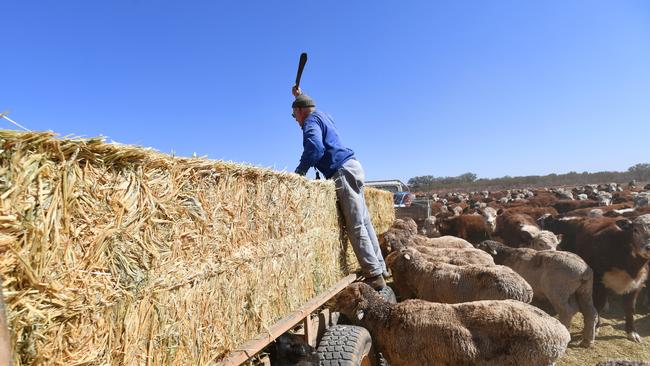Animal cruelty a fine line out where the wild things are

As police investigations go, it wasn’t the Barrier Local Area Command’s toughest assignment – the fool had posted videos of his acts on social media, the evidence having been witnessed by thousands before the cops decided to act. It is now before the court.
On Broken Hill’s many Facebook pages, the jury has not only delivered its verdict but pronounced the appropriate sentence: death. Debate exists only on the exact manner by which this capital punishment will be delivered. Many have heroically offered to take personal responsibility for the execution (“Give him to me for an hour and I’ll show him what torture is!”, etc), while others have been more explicit in their suggestions regarding the young man’s fate, the most popular methods – those that have received the most “likes” – being distinctly medieval in nature.
One such submission is that the boy be hung by the ankles from a tree out in the desert, where the animal kingdom can take revenge on his “stupid face”. Consensus is also enjoyed by the idea of a public evisceration in the town square, where locals can vent their rage so that others can see – virtue-signalling at its most brutal, for sure.
My personal favourite is the post that suggests the boy be tied “in a bag with dogs who’ve been starved for a few days”, an addendum, proposing the animals best be “put down” afterwards, reminding pet owners of their civic responsibilities.

Those foolish enough to call for calm have been ruthlessly dispatched by the virtual mob, which frequently insists those who torture and kill animals inevitably graduate to slaughtering humans, a logical fallacy that would have us believe that toad golf (as drunkenly practised in north Queensland late at night) is a gateway to genocide.
Criminologists have indeed noted many of the world’s worst serial killers directed their sadism toward animals first, but, on the other hand, Hitler had a dog – a German shepherd named Blondi – with whom he was so affectionate they shared a bed together at nights in the bunker. One might just as well assume those who sleep with their pets are destined to invade much of continental Europe.
It’s all a bit strange coming from a part of the world where the killing of animals is a way of life. It’s true the boy’s actions were senseless and cruel – he ran over the heads of living kangaroos with his motorbike and kicked kid goats in the butt as if they were Sherrins, evidently having fun while doing it. But are enjoyment and necessity the metrics by which we measure the evil inherent in an act of butchery? Is it more malicious (and I’m being the crudest of Devil’s advocates here) to kill for fun than to do so for money?
Farmers’ livelihoods are besieged by wild animals – dogs and cats, foxes and pigs, ferals all – that feast on the chickens, gorge on the cattle’s feed, guzzle the flock’s water, wreck pastures and fencing and generally interfere with the good, honest commerce of agriculture.
The steak and vegies you enjoy at the bowlo come courtesy of a wholesale bloodbath, the victim not simply the animal you’re eating, but every other animal that tried to eat it first.
Those who work the land insist there are methods of extermination more humane than others. But humans are notoriously crap at humanity, and it’s hard to be kind to a nuisance. Rare is the outback landholder who won’t confess to getting a warm glow out of closing a pest’s account, and some of the techniques employed seem as wicked as they are ingenious.

One pastoralist I know hangs chains from his porch rafters after dark, at the end of which are morsels of meat on fishhooks, temptations suspended two metres above the ground. His dogs won’t leap for food, he says, but feral cats will. It is, so he claims, a merciful death.
A late-night debate in a pub about kangaroo culling elicited an interesting response from a 60-something battle-axe who runs a station outside town. “They just need to be managed,” she said, “the poor things.”
Her compassion seemed oddly genuine, but it was clear she viewed roos not as individual entities, but as mere molecules of a living whole, like the hairs on our heads that best be sheared now and then, or a skin cancer that must be removed to save the rest of the body.
People in the cities (and I used to be one) don’t view animals that way. Out here, where wildlife is legion and unruly, unfettered by fences and collars and leads, we’re a different species.
Still, there are rules of engagement, and the boy didn’t follow them. On local media, police have warned that “vigilante acts” will be dealt with severely. The message seems to be that if you’re cruel to animals and the law doesn’t get you, the local beasts will. It’s inevitable.
An old bloke once boasted to me of his proficiency in poisoning the neighbourhood cats, who brassed him off by leaving paw prints all over his car on frosty winter mornings.
He died last year, of natural causes, and is now interred in Broken Hill Cemetery, where feral cats roam freely at night, leaving paw prints and puddles of urine wherever they please.
Jack Marx is a journalist based in Broken Hill.





Talk of the town in Broken Hill this week is a young man who’s been busted torturing animals.